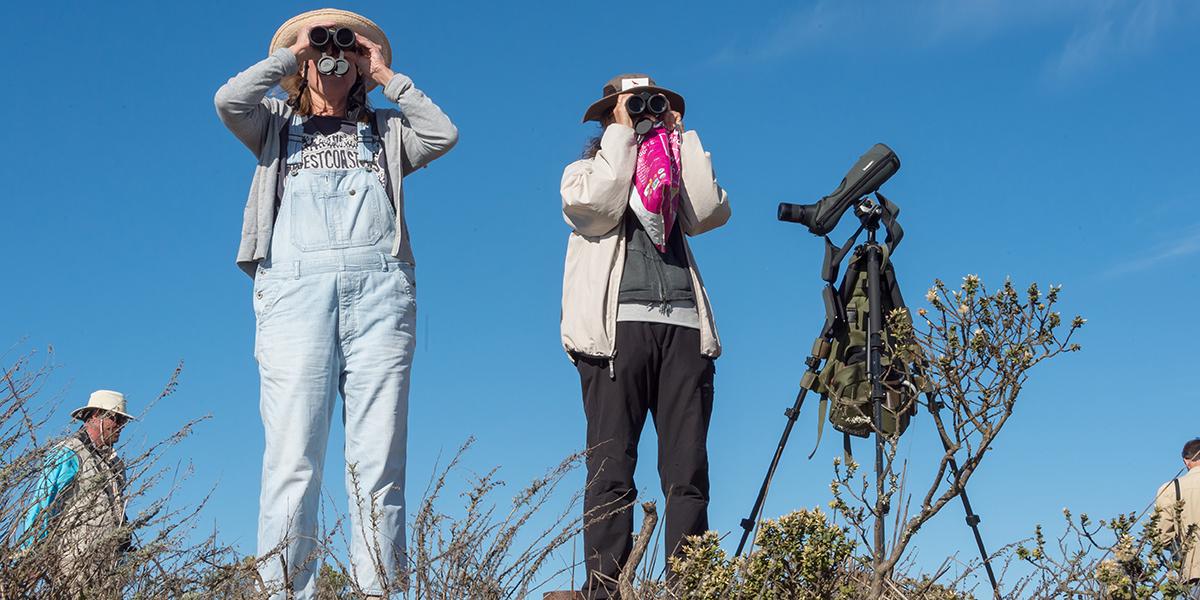Your parks need you now
Your support helps fight climate change and promote park sustainability—please give now.

The Golden Gate Raptor Observatory (GGRO) is 30 years old this fall (you might even say it’s peeking into middle age). The year 1984 was indeed a long time ago; Ronald Reagan had just been re-elected. George W. Bush was between political campaigns and fully focused on starting small oil companies. And Barack Obama, a recent Columbia grad, was taking a breather before law school and, in the fall of 1984, working for New York PIRG.
The GGRO’s foundation was put together from 1983 through 1985, and a central figure in the GGRO’s start was Golden Gate National Recreation Area ecologist Judd Howell. Experienced in raptor surveys in Montana and Arizona, Judd had a couple of fortuitous encounters in the early 1980s. The first was with Dr. Laurence Binford, curator of birds at California Academy of Sciences. Dr. Binford himself had discovered that the Marin Headlands was a hawk migration thoroughfare a decade before, and encouraged Judd to pick up the reins for more studies.
Judd’s second opportune meeting was with Will Shor, a Mill Valley falconer and raptor conservationist. The two met at Muir Beach at a park event to introduce the media to a new Peregrine Falcon release program. Prior to his transfer to the West Coast, Will had banded Peregrines on the Virginia coast at Assateague. It was just these skills that Judd needed to initiate a new National Park Service (NPS) raptor banding program in the Marin Headlands. The Golden Gate National Parks Conservancy became a full partner in 1985 and, after securing a three-year start-up grant from the San Francisco Foundation, the GGRO was off and running.
Thirty years later, what do we have to show for all this hard work and agency cooperation? For one, astounding numbers. For example, volunteers have trapped 36,498 raptors of 16 species. Just over 1,300 (3.6%) of these birds have been subsequently re-found, showing us exactly where some Golden Gate raptors have traveled—painting a beautiful map of dots from northern British Columbia to central Mexico, and from Idaho to the Farallon Islands. For 30 years, volunteers also have tallied raptors from Hawk Hill, resulting in a grand total of 709,097 raptor-sightings, the largest database of raptor populations in the Pacific States.
But beyond counts and bandings, there is much more to quantify and celebrate. The GGRO was a citizen science program long before the term “citizen science” was invented; our annual team of about 270 volunteers donate an estimated 44,000 hours of field biology services each year to make the GGRO’s work possible.
And from the hands and minds of these incredible volunteers have come many pioneering feats—for example, the first team-based, radio-tracking study of raptors in the Western States. We’ve tracked 59 raptors for thousands of miles since 1991, providing an enormous amount of detail about how the raptors strategize their migrations, and how they fly through urban areas. We’ve followed Cooper’s Hawks to the Oregon border in two days, and Broad-winged Hawks to the Mexico border in four days.
Other GGRO volunteer innovations over the years include: (1) the Robo-Lure, the first mechanical bird built to trap raptors (for banding purposes); (2) the Quadrant System, our migration count methodology, devised to ensure that Golden Gate raptors could be counted consistently for the next century, a critical device for long-term population monitoring; and (3) the Bay Area Raptor Nesting Survey, a volunteer-based system of tracking raptor nest locations and survival.
Even with all these bird biology accomplishments, perhaps the GGRO’s greatest achievement has been to fan the flames of a proud new tradition—the fall pilgrimage of people going up to Hawk Hill to see the annual migration. From birders to academics, from kids to veterans, from families to school groups to community groups, the visitation to Hawk Hill totals about 10,000 people each autumn. Every year, from September through October, GGRO hosts more than 30 weekend docent programs, during which docents share raptor ID tips, show a hawk close-up, and explain the importance of GGRO’s work to whoever shows up.
As powerful as the most basic scientific accounts may be, it is this growing constituency of support for hawks that will most likely help these extraordinary birds survive long into the future. So, please join the raptor community! As we celebrate our 30th anniversary year this fall, we would love to have your company on Hawk Hill. Come early for docent programs on Saturdays and Sundays in September and October, as the parking lot does tend to get full by around noon.
To learn more about how you can become involved or to make a donation to support the GGRO, please visit www.parksconservancy.org/ggro
Your support helps fight climate change and promote park sustainability—please give now.